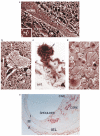Atherosclerosis
- PMID: 11001066
- PMCID: PMC2826222
- DOI: 10.1038/35025203
Atherosclerosis
Abstract
Atherosclerosis, a disease of the large arteries, is the primary cause of heart disease and stroke. In westernized societies, it is the underlying cause of about 50% of all deaths. Epidemiological studies have revealed several important environmental and genetic risk factors associated with atherosclerosis. Progress in defining the cellular and molecular interactions involved, however, has been hindered by the disease's aetiological complexity. Over the past decade, the availability of new investigative tools, including genetically modified mouse models of disease, has resulted in a clearer understanding of the molecular mechanisms that connect altered cholesterol metabolism and other risk factors to the development of atherosclerotic plaque. It is now clear that atherosclerosis is not simply an inevitable degenerative consequence of ageing, but rather a chronic inflammatory condition that can be converted into an acute clinical event by plaque rupture and thrombosis.
Figures







References
-
- Tamminen M, Mottino G, Qiao JH, Breslow JL, Frank JS. Ultrastructure of early lipid accumulation in apoE-deficient mice. Arterioscl. Thromb. Vasc. Biol. 1999;19:847–853. - PubMed
-
- Ross R. The pathogenesis of atherosclerosis: a perspective for the 1990s. Nature. 1993;362:801–809. - PubMed
-
- Libby P. Changing concepts of atherogenesis. J. Intern. Med. 1999;247:349–358. - PubMed
-
- Lusis AJ, Weinreb A, Drake TA. In: Textbook of Cardiovascular Medicine. Topol EJ, editor. Lippincott-Raven; Philadelphia: 1998. pp. 2389–2413.
Publication types
MeSH terms
Grants and funding
LinkOut - more resources
Full Text Sources
Other Literature Sources
Medical
Miscellaneous

